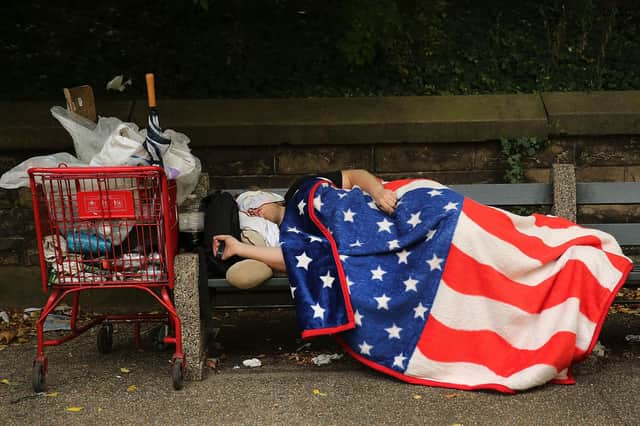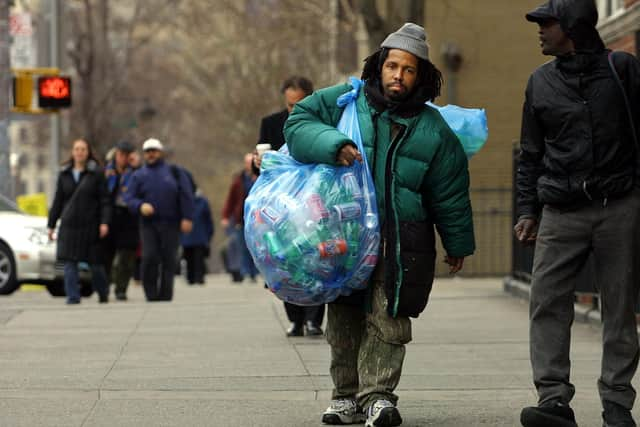In New York City, where nearly one in 100 people is homeless, I found myself inspired by hard-working treasure hunter – Professor Joe Goldblatt


When I queried him about his work upon this busy corner of Greenwich Village, he looked up with a strong sense of paranoia and said: “Shhhhh… I do not want anyone to hear us. I should not tell you this, but here goes…”
He then explained in a half-whisper that each discarded air-conditioning unit that he found contained copper, metal, aluminium and other precious metals that would soon yield him a reward of $125 to $350 when he sold the parts to a salvage company in Brooklyn. He grinned broadly and told me that previous to this occupation he sold comic books on the street. Air conditioners were much more lucrative.
Advertisement
Hide AdAdvertisement
Hide AdI noticed that nearby was a grocery cart containing all of his worldly possessions and he was filling it with the precious treasures he was extracting.
To exchange his precious cargo for cash, he would need to push his wobbly cart a distance of 12 miles. Then, after collecting the money, he would have to return to Manhattan, making a round-trip of 25 miles on foot in one day.
I complemented the gentleman upon serving as a steward of the environment through his noble recycling endeavours. He smiled and said proudly “Yes, I am an environmentalist!”
As I made my way to my office that morning, I passed by dozens more individuals who were sleeping rough or panhandling along the major thoroughfares of one of the world’s great cities.


I began to think of Frank Sinatra crooning, “if you can make it here, you can make it anywhere!” and wondered how many were not making it at all.
In January, over 45,000 people slept in homeless shelters in New York City and about 15,000 of them were children. In a city of more than eight million people, almost 80,000 people, nearly one in 106 of the population, are homeless. However, the American city with the highest homelessness rate is, surprisingly, Honolulu, Hawaii.
In Edinburgh and Glasgow, recent statistics show that Scotland’s two largest cities contain nearly 9,000 homeless people. However, homelessness applications decreased by nine per cent throughout Scotland in 2020-21.
In the United States, but there is no national plan in place to help homeless people find shelter. Instead, each city and state must develop their own unique strategy and, although they attempt to share best practices with other municipalities, this lack of collaboration often leads to missteps and wasted resources.
Advertisement
Hide AdAdvertisement
Hide AdIn Austin, Texas, I discovered one very effective solution to this city’s growing homelessness population. The Community First! Village was established by the faith-based organisation Mobile Loaves and Fishes in 1998 to provide housing for chronically homeless people.
Currently there is 52 acres of housing and they aspire to grow to 1,900 homes soon. A wide range of housing is available and residents pay a small stipend and agree to work in the community in exchange for their housing.
The smallest houses are one room and the residents use communal toilets, showers and kitchens. The cost of sponsoring a one-room home is less than £20,000. Each pre-fabricated home can be erected, complete with electrics and furniture, by a half-dozen volunteers in under four hours.
In Scotland, the well-respected charity Social Bite has created a similar village in Granton with currently 20 nest-style houses for two people that include full plumbing. According to Social Bite, their village is not a one-stop solution, rather, it is part of a much larger series of strategies required to help the homeless in our country.
Perhaps Social Bite, Community First! and any other similar projects may collaborate to share best practices to reducing homelessness just as Houston, Texas and San Diego, California did with their Housing First schemes.
Each geographic and sociographic area will require bespoke strategies. However, the opportunity to learn from one another is similar to uncovering the treasures my new friend was discovering within his air-conditioning units. Through this collaboration, perhaps Social Bite will enjoy similar growth and success as Community First!
Another opportunity for Scotland to learn from its cousins in the USA is the audacious goal set by the mayor of Seattle, Washington, who vowed to reduce homelessness from over 800 persons a night to under 30 through a multi-step plan that included bespoke programmes for each and every homeless person, carefully tailoring help to the needs of the individual.
This person-centred approach has been very successful and has attracted large donations from some of billionaires who launched giant tech conglomerates such as Microsoft.
Advertisement
Hide AdAdvertisement
Hide AdAs I looked over my shoulder at America’s newest environmental entrepreneur while he banged and clanged in search of precious copper tubing and other financial treasures, I also looked ahead at the dozens of homeless men and women upon the streets of New York City.
I could not help but wonder which direction Scotland must now pursue in the future to dramatically reduce homelessness.
Whilst the answer is complex and as, in the case of Seattle, must be customised for each individual, I firmly believe that empowering some homeless individuals with a warm home and safe neighbourhood, as in the case of Austin’s Community First!, and offering hopefulness through the rewards generated by self-effort can bring forth the type of social treasure that my friend bending over the air conditioner hoped to find.
Furthermore, I also believe that through cooperation and collaboration and best practice sharing among communities throughout the world, Scotland shall uncover this treasure much sooner and that will benefit all of us on both sides of the pond and throughout the world.
Joe Goldblatt is emeritus professor of planned events at Queen Margaret University in Edinburgh, Scotland. He is currently a visiting professor at New York University’s Jonathan M Tisch Center of Hospitality.
A message from the Editor:
Thank you for reading this article. We're more reliant on your support than ever as the shift in consumer habits brought about by coronavirus impacts our advertisers.
If you haven't already, please consider supporting our trusted, fact-checked journalism by taking out a digital subscription.
Comments
Want to join the conversation? Please or to comment on this article.
